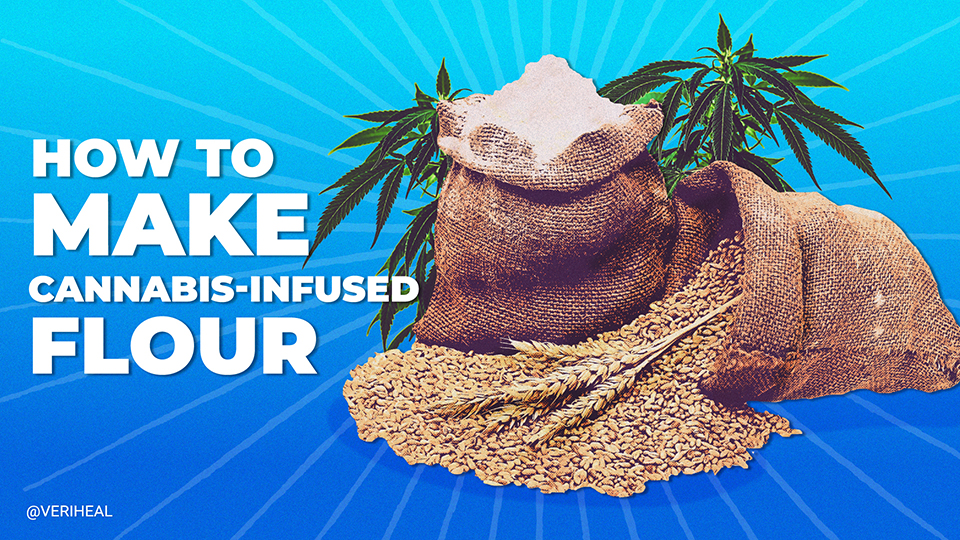Cannabis is an incredibly versatile ingredient in the kitchen. Whether it’s dessert, dinner, or drinks, cannabis can play a fantastic role in enhancing flavors and elevating experiences. And that versatility extends further to its application in a recipe. You’re probably familiar with making cannabis-infused butter or coconut oil, but did you know that you can make cannabis-infused flour—or “cannaflour”—too?
- Introduction to Cannabis Flour
- Decarbing Process
- Cannaflour Recipe
- What You Need
- Steps to Make Cannaflour
- Best Things to Cook With Cannaflour
- Savory Crepes Recipe
- Cannabis Flour Storage
- Final Takeaway
Introduction to Cannabis Flour
You should consider cannaflour an essential addition to your cannabis-friendly pantry. It is easy to store. Easy to make. And most importantly, it’s a great way to get the benefits of the whole cannabis plant. Of course, cannaflour will have a more powerful herb and terpene-laced flavor than cannabutter or other infusions, but it likely won’t smell as loud or bright as you’d expect when making cannabutter.
Working with cannaflour is slightly different from using cannabutter. You’re more likely to run into temperature issues, mainly when the flour is outside the final product (like fried chicken, for example). The temperature should stay below 340 degrees Fahrenheit to preserve potency.
However, time and form are the most significant factors that determine how far you can push the temperature. Cookies will bake best around 325-375°F and usually need 10-18 minutes in the oven.
Baking rather than cooking with cannabis flour is probably safer since the internal temperature will never reach 350°F. Recipes like fried chicken need more precise monitoring since the flour would be on the outside and directly in hot oil. Thankfully, the ideal frying temperature for chicken is about 325°F for about 12 minutes, depending on the size.
Decarbing Process
The first step to making cannabis flour is to decarboxylate the cannabis buds. Decarboxylating, or decarbing, is applying heat to raw cannabis flower to activate the THC, CBD, and any other cannabinoids in the strain. The best method to activate cannabinoids is to bake the flower in your oven using the following process:
- Preheat the oven to 240°F.
- Roughly chop up the cannabis buds and spread them in an even layer on a baking sheet or dish. Cover with tin foil.
- Bake for 30-45 minutes until the cannabis has darkened and turned slightly brown and the cannabis smell begins to overwhelm your kitchen. It will smell the same as before being baked but even more intense and slightly nuttier.
- Remove from the oven and allow it to remain covered until the pan is at least cool enough to handle (but room temperature is best) to preserve the terpenes.
For more information on decarbing cannabis and why this step is crucial when making edibles, check out our complete guide to decarboxylation.
Cannaflour Recipe
In my opinion, it’s best to make cannabis flour as needed rather than making larger batches to store. Fresh is usually best for many reasons, but especially to maintain potency. Also, cannabis flour is one of the fastest infusions to whip up, so it’s easy to decide on the fly to add it to a recipe. This recipe should take about 15 minutes if the cannabis is already decarboxylated and 1 hour if not.
The best ratio for flour to cannabis flower depends on the dose you require. That may only be a few grams or could be up to a quarter of the total weight of the flour. Depending on the recipe, you may be able to push it to an even split (half flour, half flower) without ruining the actual integrity of the recipe.
What You Need
- 3.5-30 grams decarboxylated cannabis flower, leaves, trim, or kief
- 95-120 grams (¾ cup-1 cup) all-purpose flour (or other flour of your choice)
- Kitchen scale
- Food processor/coffee grinder/blender
- Sifter/mesh strainer
- Airtight container for storage
Steps to Make Cannaflour
- Add decarbed flower to a food processor and grind to a fine powder.
- Add flour to the food processor and blend until evenly mixed.
- Sift the mixture through a sifter or mesh strainer to remove any clumps or stems.
- Use immediately or store in an airtight container for up to three months.
Best Things to Cook With Cannaflour
You can replace flour with cannabis flour in almost any recipe. Since it will have a more earthy, herbaceous flavor, it will pair well with savory recipes—think herb-covered focaccia or sourdough, gravy, breaded chicken (baked or fried), dinner pies, or pancakes. Any recipe that’s heavy on flour but light on butter or oil is ready for replacement with cannabis flour.
Savory Crepes Recipe
If you’re ready to get cooking with your freshly made batch of cannaflour, give this savory crepe recipe (adapted from Martha Stewart) a shot. The batter can be made up to a day in advance and can be frozen once cooked. Fill it with herb-friendly savory items like gruyere and ham or fresh mozzarella, basil, and tomatoes.
Time to Budget
- Prep time: 15 minutes
- Cook time: 30 minutes
- Refrigeration: 30 minutes to 24 hours
Nutrition Information
This recipe yields six 8-inch crepes.
|
Amount per Serving |
| Calories |
98 |
| Fat |
5.1 grams |
| Saturated fat |
2.9 grams |
| Cholesterol |
49 milligrams |
| Sodium |
22.9 milligrams |
| Potassium |
65.5 milligrams |
| Carbohydrates |
9.5 grams |
| Dietary fiber |
.3 grams |
| Sugar |
1.7 grams |
| Protein |
3 grams |
Ingredients
- 2 large eggs
- 63 grams (½ cup) cannaflour
- 180 grams (¾ cup) whole milk
- 21 grams (1½ tablespoons) melted butter
- 1.5 grams (¼ teaspoon) kosher salt
- Butter or oil for brushing the pan
Tools
- Blender or hand mixer
- Non-stick 10-inch skillet or griddle
Steps
- Mix all the ingredients into a smooth batter in a blender. Chill in the refrigerator for a minimum of 30 minutes, up to 24 hours.
- Preheat the oven to 325°F. Line a baking sheet with parchment paper.
- Heat a non-stick skillet to medium heat. Brush with oil or clarified butter to minimize burning and smoking.
- Pour ¼ cup of the batter into the center of the pan, swirling to create a thin, even layer of batter about 8 inches in diameter. Cook until the top of the crepe begins to look dry, about 2 minutes. Gently loosen the crepe with a spatula, flip it to the other side, and cook for another minute.
- Move the cooked crepes into the oven while working on the next to keep warm until you’re ready to serve. Alternatively, store the cooked crepes in an airtight container in the refrigerator (five days) or freezer (one month).
- To serve, top half with your desired toppings. Next, fold the crepe in half, then in half again, creating a little triangle pocket.
Cannabis Flour Storage
There are two schools of thought when it comes to storing cannabis flour. Some prefer to premix the finely ground cannabis with flour in advance. Others like to keep the decarbed cannabis powder and flour separate until it’s time to cook. In both instances, an airtight container and a cool dark place are best for storing cannaflour—similar to keeping plain flour or cannabis flower fresh. You should aim to use it within three months for optimal freshness and potency.
Final Takeaway
As cannabis flour opens new culinary doors for you, remember to start small when trying new consumption methods. It’s easy to eat more, but it is not so easy to undo. So drink plenty of water and get comfy while enjoying your new cannaflour recipes and concoctions. If you would like to learn more about using edibles or if it’s suitable for your lifestyle and needs, consult with a licensed medical cannabis doctor or cannabis coach near you.
This blog post was originally written by Kat Helgeson and published on 1/9/20. Updated 5/2/22.
Author, Share & Comments








